VSEPR_VOID
National Hazard
   
Posts: 719
Registered: 1-9-2017
Member Is Offline
Mood: Fullerenes
|
|
Synthesis of Isobutyl Nitrite (88.2% Yield) from Isobutyl Alcohol and Nitrous Acid formed in Situte
Isobutyl nitrite is a non-polar, highly flammable, volatile, solvent and vasodilator. For this reason it used in the treatment of cyanide poisoning.
It has the chemical formula C4H9NO2 and is an ester between isobutyl alcohol and nitrous acid, It has a density of 0.87g/ml, a boiling point of 67C,
and is slightly soluble in water; but generally forms a yellow, oily, organic layer on top of water.
Using this procedure, designed and performed by the author, a percent yield of 88.2% (33.6ml) can be reported. The product is a pale yellow
hydrophobic liquid with a density of 0.85 grams per ml (+/- 0.15 grams) that had a faint smell of almonds (do not deeply inhale!).
It is prepared by the addition of aqueous alkali nitrite to a solution of isobutyl alcohol and concentrated hydrochloric acid. The solution is kept
chilled by a ice bath. The isobutyl nitrite may be removed by either distillation (recommended) or decanting/pipetting the organic layer. Once
collected it is dried and washed with bicarbonate and anhydrous magnesium sulfate.
procedure
40 ml Of 31.45% hydrochloric acid (0.3213 mols) is stirred in a flask of between 200 and 150 ml with 30 ml of 99% isobutyl alcohol. The flask is then
placed in a ice bath above a magnetic stir and a thermometer added. In another container, a solution of sodium nitrite is prepared with 22.4 grams of
the salt, of 99% purity, and 35 ml of distilled water. Both solutions are left to cool to 10C. Once cool, the nitrite solution is administered drop
wise to the reaction flask with stirring. Upon addition a greenish-blue liquid briefly forms (presumably nitrous acid). This liquid quickly disperses.
If oxides of nitrogen can be seen forming than the addition is being conducted too quickly. The temperature must be kept bellow or at 10C to prevent
the loss of product. Before all the nitrite is added, a white sparkly layer will form bellow the top yellow layer. When about 90% of the nitrite
solution is added this white layer will disappear and be replaced with an arctic blue-green layer, with the top organic layer remaining unchanged.
Note: This is white layer is thought to be composed of fine droplets of isobutyl alcohol in water. When all the alcohol has been reacted away the
blue-green color is due to excess nitrous acid in solution.
The solution is left to stir for one hour. Do not reflux.
The top yellow organic layer was removed by pipette and added to a clean 250ml 24/40 rbf. Also to this flask is added 10g of sodium bicarbonate
powder. The flask was set up for simple distillation with heat supplied by steaming the bottom of the flask. The solution is distilled to 90%
completion. In total 28.3 ml of yellow hydrophobic distillate was collected.
Next the solution left after the reaction, after the organic layer was removed, was also distilled under the same conditions. From this 5.3 ml of
distillate, with the same properties as described above, was collected. The product should be dried with anhydrous magnesium sulfate.
Conclusion and Discussion
In total 33.6 ml was collected. This represents a 88.2% yield (38 ml being the theoretical).
In the future the organic layer should not be collected and distilled separately. Instead the reaction should be conducted in a 250 ml rbf and once
the reaction is finished a distillation apparatus constructed around it.
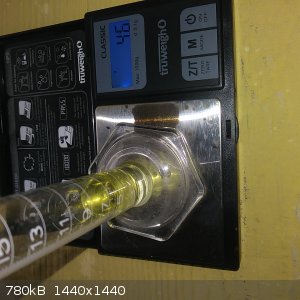 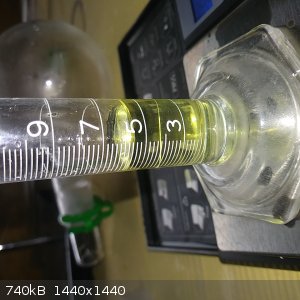 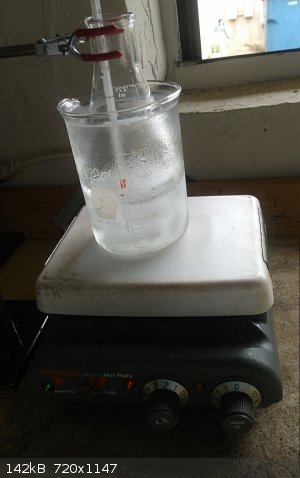 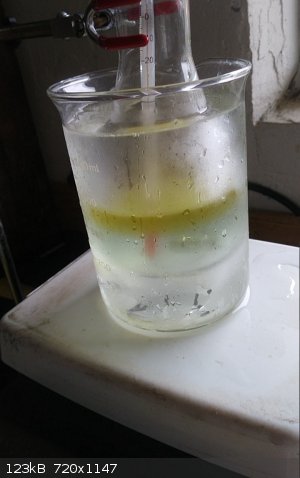 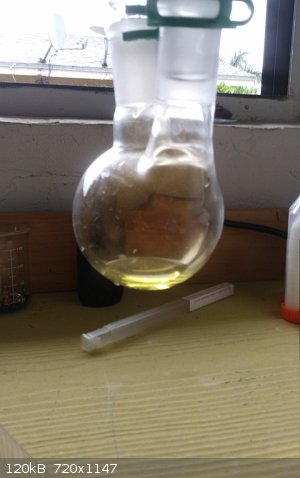 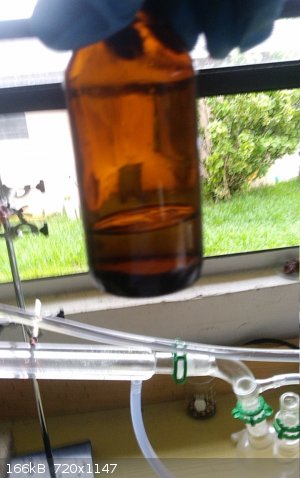
Within cells interlinked
Within cells interlinked
Within cells interlinked
|
|
|
DavidJR
National Hazard
   
Posts: 908
Registered: 1-1-2018
Location: Scotland
Member Is Offline
Mood: Tired
|
|
Enjoy your poppers 
|
|
|
VSEPR_VOID
National Hazard
   
Posts: 719
Registered: 1-9-2017
Member Is Offline
Mood: Fullerenes
|
|
No thanks. I do not plan on ingesting a volatile solvent similar to how most SM users do not huff their ether.
One use for instance is removing grease from joints. Well you can use isopropyl nitrite is hydrolyzes too quickly and is difficult to store.
It is also very easy to evaporate or boil away meaning it is wonderful for extracting hydrophobic substances.
Within cells interlinked
Within cells interlinked
Within cells interlinked
|
|
|
Melgar
Anti-Spam Agent
    
Posts: 2004
Registered: 23-2-2010
Location: Connecticut
Member Is Offline
Mood: Estrified
|
|
I make sure to have small amounts of n-butyl nitrite around, since I'm one of the only ones here who apparently can get KCN and NaCN OTC and feel like
it's only responsible to have on hand. I did try to get a strong whiff of it once, after I researched it well enough to know that it wasn't very
dangerous. It made me lightheaded and made my face flush, but didn't seem especially recreational. Maybe you have to be doing some weird sex act in
order for it to work properly? In any case, I wasn't.
Why would you ever want to use it as a solvent, is what I want to know? It's super reactive with all sorts of functional groups. I wouldn't want an
alkyl nitrite coming anywhere near any hydrophobic substance that I cared about. Diethyl ether or DCM would both be much better choices, no?
The first step in the process of learning something is admitting that you don't know it already.
I'm givin' the spam shields max power at full warp, but they just dinna have the power! We're gonna have to evacuate to new forum software!
|
|
|
VSEPR_VOID
National Hazard
   
Posts: 719
Registered: 1-9-2017
Member Is Offline
Mood: Fullerenes
|
|
Yes, you are right. It is not that great as a solvent for dissolving reactive substances but it is good for removing greases, such as those used to
seal glass. Considering that for most people ether and DCM are cheaper and more easily attained I do not recommend everyone have it on hand. It was a
fun exercise, I got to try out my new distillation setup, practice writing the procedure, and the procedure is similar to other nitrations (making it
good practice). If you make a mistake making isobutyl nitrite nothing of value is lost or explodes, the same can not be said for other reactions.
Do you have any more information on where you get your alkali cyanide OTC?
What is your full formulation for treating cyanide poisoning with isobutyl nitrite?
Within cells interlinked
Within cells interlinked
Within cells interlinked
|
|
|
DavidJR
National Hazard
   
Posts: 908
Registered: 1-1-2018
Location: Scotland
Member Is Offline
Mood: Tired
|
|
Quote: Originally posted by VSEPR_VOID  |
No thanks. I do not plan on ingesting a volatile solvent similar to how most SM users do not huff their ether.
One use for instance is removing grease from joints. Well you can use isopropyl nitrite is hydrolyzes too quickly and is difficult to store.
It is also very easy to evaporate or boil away meaning it is wonderful for extracting hydrophobic substances. |
For the record I was joking there - not suggesting that's what you were planning on using it for. Though I would be lying if I claimed I had never
used poppers...
DCM and diethyl ether both work pretty well on joint grease - at least, on the joint grease I use.
Quote: Originally posted by Melgar  | I did try to get a strong whiff of it once, after I researched it well enough to know that it wasn't very dangerous. It made me lightheaded and made
my face flush, but didn't seem especially recreational. Maybe you have to be doing some weird sex act in order for it to work properly? In any case,
I wasn't.
|
If by "weird sex act" you mean anal sex then that's the reason it's so popular in the gay community. It loosens involuntary muscles. And if taken at
just the right moment, makes orgasm particularly intense .... not that I'd know cough.
[Edited on 27-5-2018 by DavidJR]
|
|
|
j_sum1
Administrator
       
Posts: 6221
Registered: 4-10-2014
Location: Unmoved
Member Is Online
Mood: Organised
|
|
[moderating]
Back on topic, DavidJR.
No one needs this.
[/moderating]
|
|
|
Melgar
Anti-Spam Agent
    
Posts: 2004
Registered: 23-2-2010
Location: Connecticut
Member Is Offline
Mood: Estrified
|
|
Quote: Originally posted by VSEPR_VOID  | Do you have any more information on where you get your alkali cyanide OTC?
What is your full formulation for treating cyanide poisoning with isobutyl nitrite? |
Alkali cyanides can be purchased from a jeweler's supply store in the diamond district of Manhattan, in NYC. They also sell nitric acid for
$60/gallon, and a bunch of other fun stuff that's useful for precious metal chemistry.
Although I haven't had to treat myself or anyone else for cyanide poisoning yet, I'd start by leaving the area where there's any cyanide gas present.
(Note that this would probably not work for ingesting the stuff, but I'm operating under the assumption that I'm competent enough to avoid that route
of administration.) Then open the bottle, hold one nostril closed, and inhale strongly through my nose several times.
Alkali nitrites convert some of the hemoglobin in your blood into methemoglobin, which cyanide preferentially binds to. Cyanide works by binding to
cytochrome oxidase, but will switch to binding to methemoglobin if any is present. This gives your body a wider window during which it can metabolize
the cyanide and convert the methemoglobin back to regular hemoglobin.
This all assumes that I can get myself to a cyanide-free area with normal oxygen levels and reduce physical activity enough to lower my need for
oxygen. It also assumes I'd be able to notice the effects of cyanide poisoning. Granted, I have no experience doing this, and don't know how well it
would work if I did, but it still seems prudent to have something that could work on hand.
Incidentally, alkyl nitrites aren't supposed to have very long shelf lives. They're apparently both decomposed by acids and decompose into acids.
However, storing them over sodium carbonate is supposed to help with this, so that's how I store mine.
The first step in the process of learning something is admitting that you don't know it already.
I'm givin' the spam shields max power at full warp, but they just dinna have the power! We're gonna have to evacuate to new forum software!
|
|
|
VSEPR_VOID
National Hazard
   
Posts: 719
Registered: 1-9-2017
Member Is Offline
Mood: Fullerenes
|
|
Quote: Originally posted by Melgar  | Quote: Originally posted by VSEPR_VOID  | Do you have any more information on where you get your alkali cyanide OTC?
What is your full formulation for treating cyanide poisoning with isobutyl nitrite? |
Alkali cyanides can be purchased from a jeweler's supply store in the diamond district of Manhattan, in NYC. They also sell nitric acid for
$60/gallon, and a bunch of other fun stuff that's useful for precious metal chemistry.
Although I haven't had to treat myself or anyone else for cyanide poisoning yet, I'd start by leaving the area where there's any cyanide gas present.
(Note that this would probably not work for ingesting the stuff, but I'm operating under the assumption that I'm competent enough to avoid that route
of administration.) Then open the bottle, hold one nostril closed, and inhale strongly through my nose several times.
Alkali nitrites convert some of the hemoglobin in your blood into methemoglobin, which cyanide preferentially binds to. Cyanide works by binding to
cytochrome oxidase, but will switch to binding to methemoglobin if any is present. This gives your body a wider window during which it can metabolize
the cyanide and convert the methemoglobin back to regular hemoglobin.
This all assumes that I can get myself to a cyanide-free area with normal oxygen levels and reduce physical activity enough to lower my need for
oxygen. It also assumes I'd be able to notice the effects of cyanide poisoning. Granted, I have no experience doing this, and don't know how well it
would work if I did, but it still seems prudent to have something that could work on hand.
Incidentally, alkyl nitrites aren't supposed to have very long shelf lives. They're apparently both decomposed by acids and decompose into acids.
However, storing them over sodium carbonate is supposed to help with this, so that's how I store mine. |
I plan on storing my own supply of isobutyl nitrite with anhydrous magnesium sulfate and sodium bicarbonate.
I am surprised that you can buy cyanides. I would think that the seller would require some identification or paper work before selling them to you.
Within cells interlinked
Within cells interlinked
Within cells interlinked
|
|
|
XeonTheMGPony
International Hazard
    
Posts: 1636
Registered: 5-1-2016
Member Is Offline
Mood: No Mood
|
|
for countering cyanide poisoning methylene blue is all so administered via iv or injection.
https://en.wikipedia.org/wiki/Methylene_blue
|
|
|
DavidJR
National Hazard
   
Posts: 908
Registered: 1-1-2018
Location: Scotland
Member Is Offline
Mood: Tired
|
|
Apologies!
|
|
|
Boffis
International Hazard
    
Posts: 1836
Registered: 1-5-2011
Member Is Offline
Mood: No Mood
|
|
Alkyl nitrites are very usefull reagent in organic synthesis. For instance they react with reactive methylene groups in the presence of HCl gas or
sometimes even a little conc hydrochloric acid and with reactive methyl group usually in the presence of a sodium alkoxide to yield oximes. Butyl
nitrite for instance reacts with ethyl methyl ketone in the presence of a little HCl to give 2,3-butadione monoxime which is the starting material for
the preparation of dimethylglyoxime etc (See Vogel, Textbook of Preparative Organic Chemistry, 3 edition).
With acetophenone and sodium ethoxide you get phenylglyoxal-2-oxime (so called isonitrosoacetophenone).
|
|
|
DavidJR
National Hazard
   
Posts: 908
Registered: 1-1-2018
Location: Scotland
Member Is Offline
Mood: Tired
|
|
They can also be used to prepare azides.
|
|
|
LearnedAmateur
National Hazard
   
Posts: 513
Registered: 30-3-2017
Location: Somewhere in the UK
Member Is Offline
Mood: Free Radical
|
|
Actually neither of those are huge issues, saying that from experience having made a couple of hundred mils in small batches. Isopropyl nitrite
hydrolyses quite slowly when not in the presence of an acid, storing over a small amount of sodium carbonate solution helps. I used to store it in a
small stoppered test tube within a bunged boiling tube and it lasts for several months with minimal degradation. Alternately, a glass reagent bottle
with PFTE tape on the thread will store it nicely as well, so long as there is no gap for it to evaporate through.
In chemistry, sometimes the solution is the problem.
It’s been a while, but I’m not dead! Updated 7/1/2020. Shout out to Aga, we got along well.
|
|
|
VSEPR_VOID
National Hazard
   
Posts: 719
Registered: 1-9-2017
Member Is Offline
Mood: Fullerenes
|
|
Quote: Originally posted by LearnedAmateur  |
Actually neither of those are huge issues, saying that from experience having made a couple of hundred mils in small batches. Isopropyl nitrite
hydrolyses quite slowly when not in the presence of an acid, storing over a small amount of sodium carbonate solution helps. I used to store it in a
small stoppered test tube within a bunged boiling tube and it lasts for several months with minimal degradation. Alternately, a glass reagent bottle
with PFTE tape on the thread will store it nicely as well, so long as there is no gap for it to evaporate through. |
From what I heard you want to store it with a weak base and a drying agent in a cold dark place. I ordered some more magnesium sulfate for this
purpose among other things. The higher molecular weight nitrites degrade slower than the lighter species, for example isopropyl nitrite.
I am considering trying to prepare a nitrite ester of resorcinol by a similar method.
Within cells interlinked
Within cells interlinked
Within cells interlinked
|
|
|
Melgar
Anti-Spam Agent
    
Posts: 2004
Registered: 23-2-2010
Location: Connecticut
Member Is Offline
Mood: Estrified
|
|
From my experience, magnesium sulfate isn't the best choice. It pulls water out of solution, but not acids; in fact, it prevents acids from being
neutralized. Better to use sodium carbonate exclusively. Sodium bicarbonate releases twice as much water as the carbonate salt as it's neutralized,
which isn't necessarily bad. But it also produces more bubbles of CO2, which isn't ideal.
Since I believe alkyl nitrites produce nitric and nitrous acids when they degrade, and because both sodium nitrate and sodium nitrite are hygroscopic,
that means sodium carbonate is typically sufficient as a desiccant.
Quote: Originally posted by Boffis  | Alkyl nitrites are very usefull reagent in organic synthesis. For instance they react with reactive methylene groups in the presence of HCl gas or
sometimes even a little conc hydrochloric acid and with reactive methyl group usually in the presence of a sodium alkoxide to yield oximes. Butyl
nitrite for instance reacts with ethyl methyl ketone in the presence of a little HCl to give 2,3-butadione monoxime which is the starting material for
the preparation of dimethylglyoxime etc (See Vogel, Textbook of Preparative Organic Chemistry, 3 edition).
With acetophenone and sodium ethoxide you get phenylglyoxal-2-oxime (so called isonitrosoacetophenone). |
I actually prefer doing this reaction with methanol, as it allows for very easy separation of the methyl nitrite, since it's a gas at room
temperature. I typically add windshield wiper fluid (mix of methanol and water) and sulfuric acid together, then chill that, then drip a solution of
sodium nitrite into that. And sodium nitrite is extremely highly soluble in water, so you can add quite a lot of it in a small volume without needing
to start with a very large flask. When the bubbling slows down a lot, I just switch the funnel to adding H2SO4 solution instead, and the bubbling
starts right back up. That way I can calculate yield and moles based solely on sodium nitrite used, without having to know the concentration of the
windshield washer fluid or the sulfuric acid I'm using. (ie, I always make sure to end by dripping in acid solution)
edit: The gas from the reaction flask is then channeled into a chilled flask of methanol containing the carbonyl compound you want to perform this
reaction with. I believe you also need to bubble anhydrous HCl into the methanol first, however it's mainly needed as a catalyst, and is not used up.
The methyl nitrite is converted into methanol.
[Edited on 5/30/18 by Melgar]
The first step in the process of learning something is admitting that you don't know it already.
I'm givin' the spam shields max power at full warp, but they just dinna have the power! We're gonna have to evacuate to new forum software!
|
|
|
aga
Forum Drunkard
    
Posts: 7030
Registered: 25-3-2014
Member Is Offline
|
|
Excellent work VSEPR_VOID !
Thank you for sharing the details and the photos of your synthesis.
|
|
|